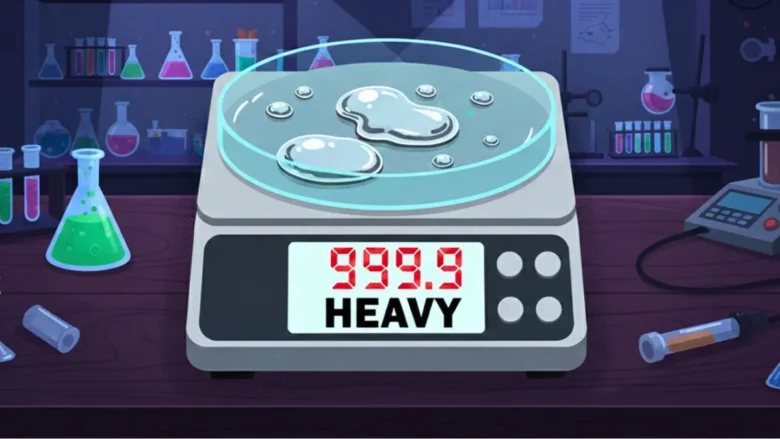The densest materials on Earth come from both natural sources and human work in labs. Scientists measure density to understand how tightly atoms pack together. This helps them learn where these materials form, how they behave under pressure, and why industries rely on them.
Densest Materials on Earth
| Element | Density (×10³ kg/m³) |
|---|---|
| Osmium | 22.6 |
| Iridium | 22.4 |
| Platinum | 21.5 |
| Rhenium | 21.0 |
| Plutonium | 19.8 |
| Gold | 19.3 |
| Tungsten | 19.3 |
| Uranium | 18.8 |
| Tantalum | 16.6 |
| Mercury | 13.6 |
| Rhodium | 12.4 |
| Thorium | 11.7 |
| Lead | 11.3 |
| Silver | 10.5 |
The densest naturally occurring material on Earth is osmium, a rare metal with a density of 22,600 kg/m³. Found in platinum ores, osmium’s atoms are incredibly tightly packed, making it heavier per unit volume than almost anything else. Its bluish-silver sheen and extreme hardness also make it a standout. However, it’s toxic and expensive.
Right behind osmium is iridium, with a density of 22,400 kg/m³. This corrosion-resistant metal is often found in meteorites and used in high-tech alloys. Platinum, at 21,500 kg/m³, is another dense metal, prized for jewelry and industrial applications. Both are heavyweights but fall just short of osmium’s record.
Several other metals rank high on the density scale. Rhenium (21,000 kg/m³) is used in jet engines due to its durability. Gold and tungsten, both at 19,300 kg/m³, are well-known for their weight and value. Uranium (18,800 kg/m³) and plutonium (19,800 kg/m³) are notable for their nuclear applications, though plutonium is mostly synthetic.
Lab-Made Materials
In laboratories, scientists have created even denser elements. Hassium, element 108, tops the list with an estimated density of 40,700 kg/m³. This superheavy, synthetic element is radioactive, with a half-life of just seconds. Meitnerium, element 109, follows at 37,400 kg/m³, but both are too unstable for practical use.
Why Does Density Matter?
Density affects many things around us. In radiation shielding, lead works well because it has a lot of mass in a small space, so it blocks X-rays with thinner walls. Tungsten does a similar job in space probes, helping protect equipment from cosmic rays without adding too much weight.
In everyday life, your phone’s vibration motor feels strong because it has a small, dense weight inside it. Submarines use dense metal parts so they can handle high pressure underwater. In hospitals, dense iodine compounds help doctors see organs clearly during scans.
Density of Neutron Stars
Now compare that to space. Neutron stars make everything on Earth look light. They form when a large star dies and gravity squeezes its core so tightly that electrons and protons combine into neutrons. The result is a super-dense object: about 3.7 to 6 × 10¹⁷ kg/m³.
Imagine something the size of a city with more mass than the Sun. A sugar cube of neutron star material would weigh as much as Mount Everest. We notice neutron stars as pulsars, which spin and send out beams of radiation, or as magnetars, which have extremely strong magnetic fields. Some may reach densities near 10¹⁸ kg/m³.
Nuclear Density
Inside atoms, the nucleus is also very dense. On average, nuclear density is around 2.3 × 10¹⁷ kg/m³, and it stays almost the same no matter which element you pick. For example, a uranium-238 nucleus is only a few femtometers wide, but all its protons and neutrons are packed together by the strong nuclear force.
Neutron stars are similar: they’re basically giant balls of neutron-rich matter. That’s why they’re so hard to crush. Add too much mass, and they collapse into a black hole.
Why Don’t We Use Super-Dense Materials?
Some elements are even denser than lead or tungsten, but we can’t use them. Elements like hassium last only seconds before decaying and releasing dangerous radiation. Osmium and iridium are stable, but they’re rare and very expensive. Plutonium is highly controlled.
So for now, we rely on materials that are safe, stable, and affordable. Lead for shielding, tungsten for heat and impact resistance, and gold for electronics. New discoveries may give us stronger, denser metals in the future, but current limits come from cost, safety, and availability.

